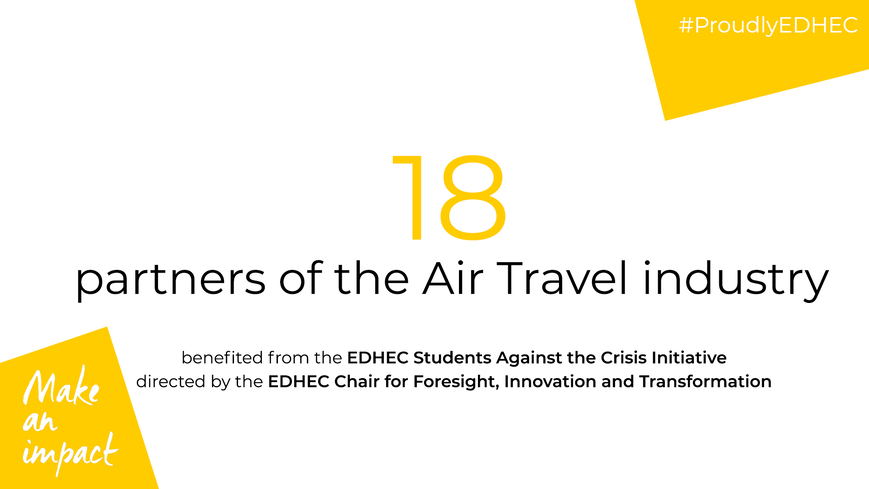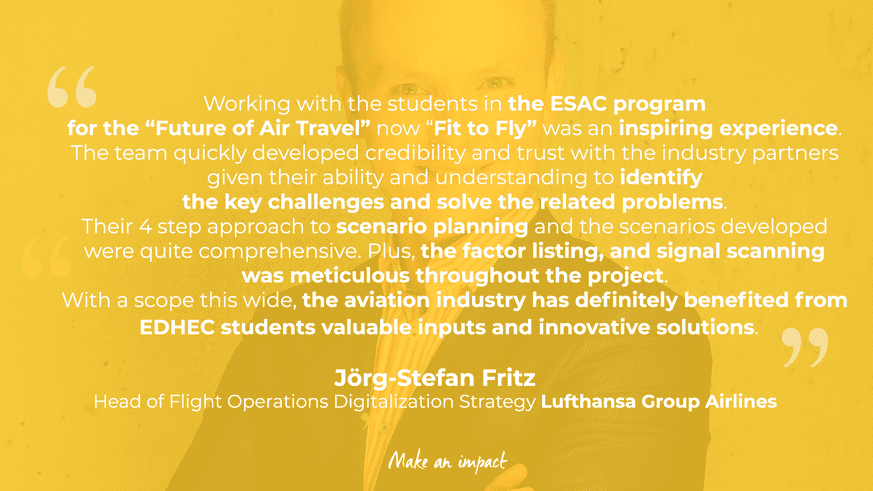Future [FIT]ness: Partnering with the airline industry during crisis
The EDHEC Student Against the Crisis was a collaboration between students and companies to create strategies that would help them address critical issues posed by the Covid-19 pandemic in a way that…

The EDHEC Student Against the Crisis was a collaboration between students and companies to create strategies that would help them address critical issues posed by the Covid-19 pandemic in a way that also served their long-term future. It was led by René Rohrbeck, Professor of Strategy, and the head of EDHEC's Foresight, Innovation & Transformation ( FIT) Chair. Thanks to the unique methodology created by the FIT Chair, the ESAC team managed to open up new horizons to the airline industry. Professor Rohrbeck is telling this story.
By early April, as governments around the world were closing their doors to the travelers, the aviation industry was quickly brought to its knees from the dual headwinds created by the dramatic economic and social fall-out of the pandemic. Airlines rushed into an emergency and started predicting the longevity of the impact. The assumption was between 3 months and 24 months. Companies worldwide started restructuring operations and shuffling their commercial planes to fulfil the increased cargo requirements. However, this was only a temporary response to the crisis. It also brought the industry to notice and reassess their strategies for times like this in the future.
Today, over 6 months since the first impact, airlines are still running at less than 50% capacity. Our research suggests that radical changes will be needed to better serve new customer segments. We also realized during our study that there is more to just finding technological solutions to fight the imminent crisis.
To do so, a diverse team of 10 students from the EDHEC Masters and MBA programs volunteered to help our project partners, including two major airlines (one European, one Middle Eastern), two major airports in Europe, manufacturers and travel service providers to explore their options using the 4-step methodology developed by the FIT Chair for finding opportunity in crisis.
Phase 1: Building a trend radar
One of the principal reasons that firms struggle with decision making during a crisis is because the external factors are hard to predict & anticipate. So, we began to develop a radar for the highly impactful Political, Economic, Social and Technological factors. With the help of the partners, we developed 70+ drivers and shortlisted the top 35 influential ones. It helped the partners and our team broaden our vision to continuously spot emerging opportunities and threats. For instance, factors like multi-modal mobility and trust in global health governance topped our impact-uncertainty matrix. A general discussion would often miss these factors and focus on more short-term ad-hoc solutions such as the development of vaccines and disinfection technology. The newly discovered factors now have the potential to be a part of the solution.
Phase 2: Building plausible scenarios
Scenarios help us visualise how the future might evolve. During an interactive workshop, the team-built narratives using key drivers of change from the Itonics platform. It revealed that the industry was the least prepared for the most likely scenario and that the old model of Hub and Spoke with business and leisure travelers sharing the network and planes might be unrealistic for a while.
Phase 3: Gauging challenges and finding solutions
As per the method, we must thoroughly scan the two worlds - external & internal to build robust strategies. And with the external scanning done, the team went on to examine the internal world i.e. what would need to happen in-order to make the passengers feel safe during air travel. The aim was to understand the willingness to travel for current travel groups and their frustrations. We mapped the customer journey in three phases– pre-flight, in-flight, and post-flight. They were then subdivided into 8 parts beginning with the decision to travel and ending at the destination. We then gathered the pain points by employing a qualitative approach, scanning reports, interviewing passengers and from the insights provided by the partners. This allowed us to create a passenger mood graph, which brought the moments of ambiguity and discomfort in choosing your next travel destination into the spotlight.
In early September, 18 partners of the Future of Air Travel and the student team came together to review the pain points in the 8-step customer journey and perform the propensity to travel assessment for the identified travel group personas. We also developed and evaluated solutions that could be implemented in less time giving high value at every vertical of the aviation value chain.
The solutions rated in terms of the value offered and time to implement provided a crucial first glimpse of how your next airline journey would look and feel.




